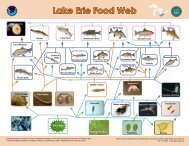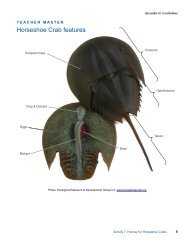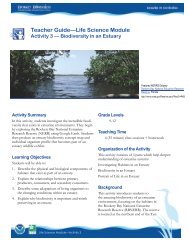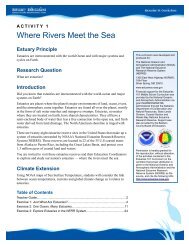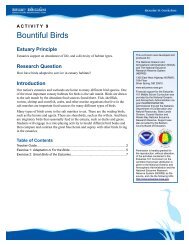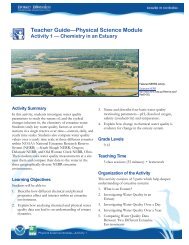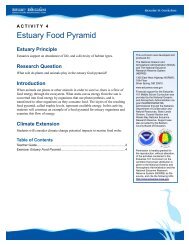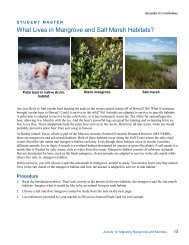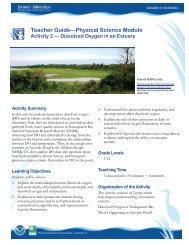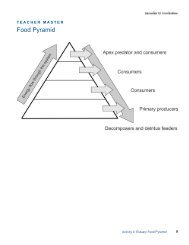Teacher GuideâEarth Science Module - Estuaries NOAA
Teacher GuideâEarth Science Module - Estuaries NOAA
Teacher GuideâEarth Science Module - Estuaries NOAA
Create successful ePaper yourself
Turn your PDF publications into a flip-book with our unique Google optimized e-Paper software.
Part 4 — Salinity as Measured by Water QualityStations in York RiverHaving seen what a theoretical salinity distribution canlook like in the river, students now observe actual salinitydata for a specific day at five different sites along theriver. You can do this activity either using computeraccess to near-current data or using the prepared datagraphs in the Student Data Sheet — Salinity and Tide Data forYork River.Select data for the same date at each station.Students may select a date of their own choosing,but for the purposes of this initial activity, it willbe best for the whole class to choose the samedate for the sake of consistency when they arediscussing results.Observe graphs of salinity data for that day at eachsite. It will be helpful for students to print outgraphs for each site so they can compare changesfrom site to site, over time.13. If you use the computer access to data, follow theinstructions in the Student Worksheet — Salinity andTides. If you use the prepared graphs, hand them outto students.Students will: Read information about the station including Salinityregime, Mean tidal range, Meanwater depth, and Adjacent water. Make predictions about how fresher and saltier waterwill mix, and how salinity changes throughout the daywill differ from site to site.14. Encourage students to correlate the salinity graphsat the five sites with the generalizeddistribution shown in the animation. Studentsshould pay particular attention to the graphs ofGloucester Point, Yorktown, and Clay Bankbecause this is the area marked by the threereference points in the animation.15. Have students answer the questions in Part 4 ofthe Student Worksheet — Salinity and Tides.Check for Understanding1. Discuss the following: How do the changes at each monitoring stationcompare with changes at those same areas in theanimation? Name several factors that determine why salinitychanges are different depending on your locationwithin the estuary.2. Ask small groups to use their handouts to answer thisquestion. Collect this assignment and use it as a final assessment.Imagine that an intense rainstorm dumps 3 inches ofrain over the entire Chesapeake Bay region. Predicthow the salinity would change at all four stations in thebay for a period of 24 hours after the storm ends. Supplya graph and an explanation of what you might expectto see at each station.Optional Extension Inquiries1. Have students access other data from the VIMS site tosee how factors such as precipitation and temperaturemight have affected salinity on that date.2. Have students investigate tides and salinity from otherNERRS estuaries, using the Data Graphing Applicationon: http://estuaries.gov/<strong>Science</strong>Data/Graphing.aspx3. Other related activities include: NOS Tides Lesson Plansoceanservice.noaa.gov/education/kits/tides/supp_tides_lessons.htmlEarth <strong>Science</strong> <strong>Module</strong>—Activity 25



